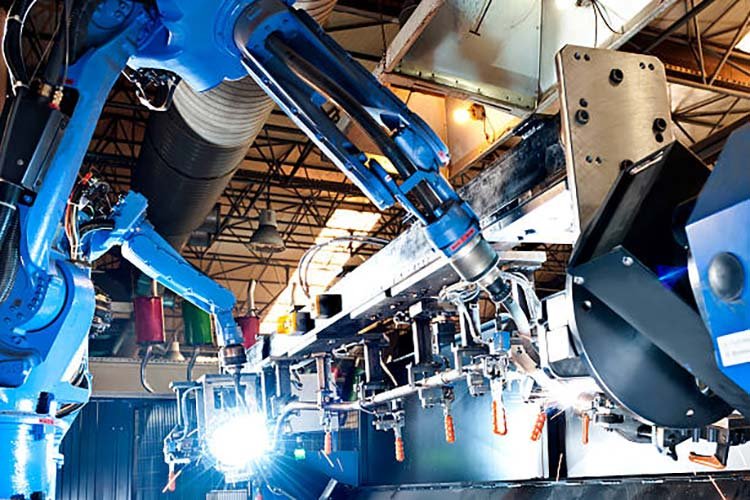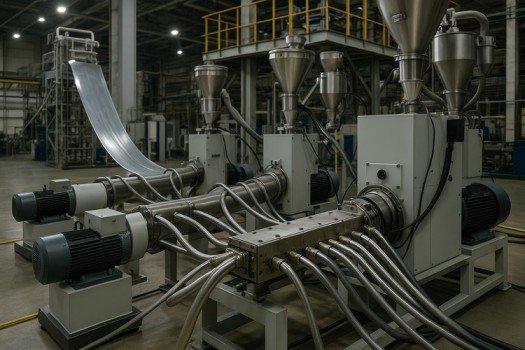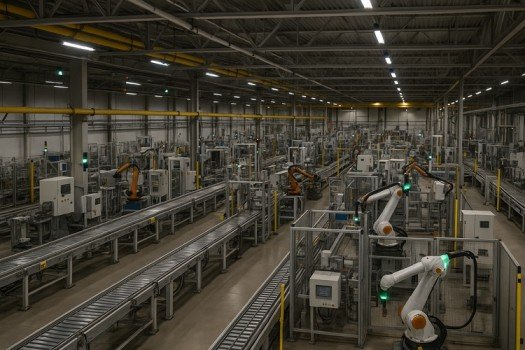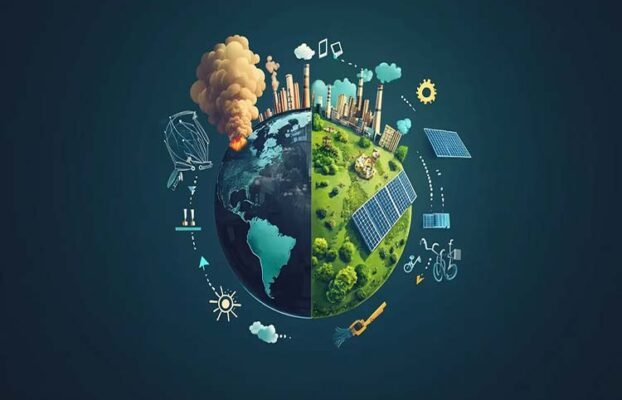Defining Industrial Machinery: The Engine of Industry
At its core, industrial machinery refers to a broad category of mechanical equipment and systems used in manufacturing, production, construction, and other industrial processes. Unlike consumer goods, industrial machinery is typically designed for heavy-duty, continuous operation, often in harsh environments, to facilitate mass production, optimize efficiency, and perform tasks that are either impossible or impractical for human labor alone.
Key characteristics often associated with industrial machinery include durability and robustness, meaning it’s built to withstand high stresses, vibrations, and continuous operation. It also boasts high performance and precision, capable of executing complex tasks with accuracy and speed. Furthermore, industrial machinery is often specialized, designed for specific functions within a particular industry, and exhibits scalability, ranging from small, specialized tools to massive, integrated production lines. Increasingly, it incorporates automation and control through advanced sensors, robotics, and artificial intelligence for autonomous operation and remote management.
Types of Industrial Machinery
The realm of industrial machinery is vast and incredibly diverse, with equipment categorized based on its function, industry application, and operational principles.
1. Manufacturing and Production Machinery
This category encompasses equipment directly involved in transforming raw materials into finished goods, forming the very heart of any factory floor. Machine tools are fundamental for shaping and fabricating parts, including lathes for turning cylindrical shapes, milling machines for material removal with rotating cutters, drilling machines for creating holes, and grinding machines for achieving high precision and smooth finishes. Modern manufacturing heavily relies on CNC (Computer Numerical Control) machines, which are automated machine tools following pre-programmed instructions for high precision and repeatability.
Beyond shaping, forming machinery changes the shape of materials without removing material. This includes presses for stamping, bending, forging, and extruding metals, bending machines for sheet metal and pipes, and roll forming machines for continuously bending long strips of metal into desired cross-sections. For joining materials, typically metals by fusion, welding equipment like MIG/TIG welders and spot welders are crucial, with robotic welders handling high-volume, precise tasks.
Assembly machinery automates the process of putting components together, utilizing robotic arms for versatile pick-and-place, assembly, and inspection tasks, often integrated into automated assembly lines for sequential operations. Finally, packaging machinery is used for wrapping, filling, sealing, and labeling products. This includes filling machines for liquids, powders, and granular products, sealing machines to secure packaging, labeling machines for applying labels, and cartoning machines to erect, fill, and close cartons.

2. Material Handling Equipment
Crucial for the movement, storage, control, and protection of materials throughout manufacturing, distribution, consumption, and disposal processes, material handling equipment ensures efficiency in logistics. Conveyor systems enable the continuous movement of goods along a fixed path, with types such as belt conveyors for general transport, roller conveyors for flat-bottomed items, and overhead conveyors for maximizing floor space.
For lifting and moving heavy loads vertically and horizontally, cranes and hoists are indispensable. This includes overhead cranes running on elevated runways, gantry cranes which are self-supporting structures, and jib cranes mounted on a wall or column with a rotating arm. Shorter-distance transport of palletized goods relies on forklifts and pallet jacks. Advancements in automation have introduced Automated Guided Vehicles (AGVs) and Autonomous Mobile Robots (AMRs) for driverless material transport within facilities, along with Automated Storage and Retrieval Systems (AS/RS) for efficient warehouse management.
3. Construction and Heavy Machinery
Designed for large-scale earthmoving, building, and infrastructure projects, construction machinery tackles the biggest jobs. Key examples include excavators for digging, trenching, and demolition, bulldozers for pushing and grading earth, and loaders for scooping and moving loose materials. Large-scale cranes are used extensively in building construction, while road rollers compact asphalt and soil. For concrete work, concrete mixers and pumps are essential, and piling rigs are used to drive piles into the ground to support structures.
4. Agricultural Machinery
Essential for modern farming, agricultural machinery significantly increases efficiency and output. The tractor serves as the primary power source for various implements. Plows and cultivators prepare the soil, while seeders and planters are used for planting crops. Harvesters (combines) are critical for reaping, threshing, and cleaning grain crops, and irrigation systems ensure efficient crop watering. Finally, sprayers are used for applying fertilizers and pesticides.
5. Energy and Power Generation Machinery
This equipment is used in the production and distribution of energy. Turbines (steam, gas, wind, hydro) convert various forms of energy into rotational energy to drive generators, which then convert mechanical energy into electrical energy. Boilers generate steam for power generation and industrial processes, while transformers modify voltage levels in electrical grids. Pumps are widely used for moving fluids in power plants and various industrial applications.
6. Specialized Industry Machinery
Many industries have unique machinery tailored to their specific processes. For instance, the textile industry uses looms, spinning machines, and knitting machines. Food processing relies on ovens, mixers, slicers, freezers, and bottling lines. The mining sector employs drills, crushers, conveyors, and haul trucks. Chemical processing involves reactors, heat exchangers, distillation columns, and centrifuges, and the pharmaceutical industry utilizes tablet presses, capsule filling machines, and sterile packaging equipment.
What is Industrial Machinery Used For? Indispensable Applications
The applications of industrial machinery are virtually limitless, underpinning almost every sector of the global economy.
In manufacturing and production, its most obvious and pervasive use, industrial machinery produces everything from automobiles and electronics to consumer goods, textiles, and food products. It enables mass production, ensures consistency, and significantly reduces per-unit costs. For construction and infrastructure development, heavy machinery is indispensable for building roads, bridges, skyscrapers, dams, and other vital infrastructure, enabling large-scale earthmoving, material handling, and precise construction.
Agriculture and food production benefit immensely, as machinery from preparing fields and planting seeds to harvesting crops and processing food dramatically increases efficiency and output, ensuring global food supply. In mining and resource extraction, specialized machinery is crucial for extracting raw materials like coal, minerals, and oil and gas from the earth, often in challenging environments.
Energy generation and distribution heavily rely on industrial machinery like turbines and generators to produce electricity, while other equipment facilitates its distribution. In logistics and warehousing, material handling equipment is vital for the efficient storage, retrieval, and movement of goods, optimizing inventory management and delivery times. Furthermore, machinery is increasingly used in recycling and waste management to sort, process, and compact waste materials, contributing to environmental sustainability. Even in research and development, specialized industrial machinery is often used in laboratories to create prototypes, test new materials, and develop innovative products and processes.

The Future of Industrial Machinery: Automation, AI, and Sustainability
The industrial machinery landscape is continuously evolving, driven by advancements in technology and growing demands for efficiency, sustainability, and flexibility. Key trends shaping the future include increased automation and robotics, with further integration of autonomous systems to reduce manual labor, improve precision, and enable 24/7 operation. Artificial Intelligence (AI) and Machine Learning (ML) are being applied for predictive maintenance, optimizing production processes, quality control, and even design.
Internet of Things (IoT) integration connects machinery to the internet for real-time data collection, remote monitoring, and enhanced decision-making. While not traditional “machinery,” additive manufacturing (3D printing) at an industrial scale is transforming manufacturing by enabling the creation of complex parts with less waste.
There’s also a growing focus on sustainability and energy efficiency, with the development of machinery that consumes less energy, produces less waste, and utilizes environmentally friendly materials. Finally, the demand for customization and flexibility is driving the development of machinery that can be easily reconfigured to produce diverse products in smaller batches, catering to market demands for personalized goods.
Conclusion
Industrial machinery is far more than just steel and circuits; it is the fundamental enabler of global industry, innovation, and progress. From the smallest precision tools to the largest earthmovers, these machines are tirelessly working behind the scenes, shaping our world, driving economic growth, and continually pushing the boundaries of what’s possible. Understanding its diverse types and critical applications is essential for anyone seeking to comprehend the intricate workings of modern industry and its future trajectory.









